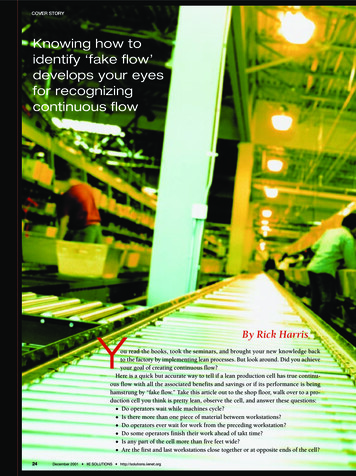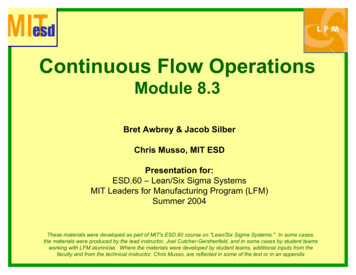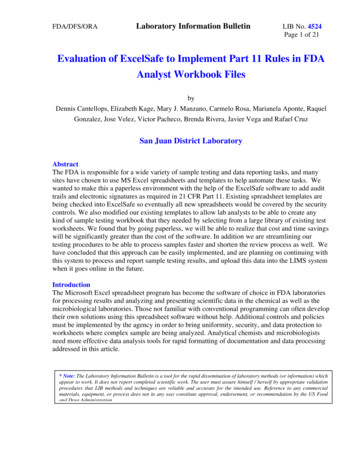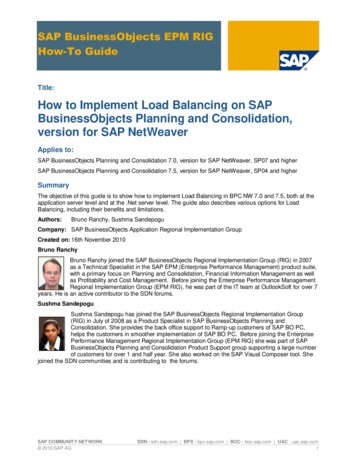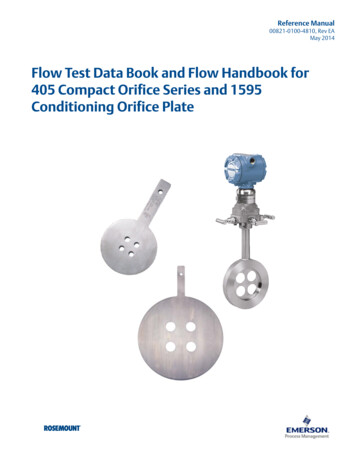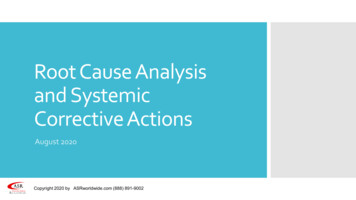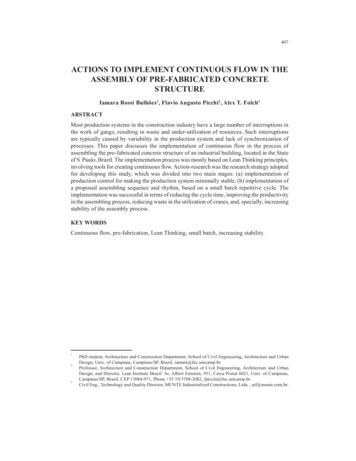
Transcription
407ACTIONS TO IMPLEMENT CONTINUOUS FLOW IN THEASSEMBLY OF PRE-FABRICATED CONCRETESTRUCTUREIamara Rossi Bulhões 1, Flavio Augusto Picchi2, Alex T. Folch3ABSTRACTMost production systems in the construction industry have a large number of interruptions inthe work of gangs, resulting in waste and under-utilization of resources. Such interruptionsare typically caused by variability in the production system and lack of synchronization ofprocesses. This paper discusses the implementation of continuous flow in the process ofassembling the pre-fabricated concrete structure of an industrial building, located in the Stateof S Paulo, Brazil. The implementation process was mostly based on Lean Thinking principles,involving tools for creating continuous flow. Action-research was the research strategy adoptedfor developing this study, which was divided into two main stages: (a) implementation ofproduction control for making the production system minimally stable; (b) implementation ofa proposed assembling sequence and rhythm, based on a small batch repetitive cycle. Theimplementation was successful in terms of reducing the cycle time, improving the productivityin the assembling process, reducing waste in the utilization of cranes, and, specially, increasingstability of the assembly process.KEY WORDSContinuous flow, pre-fabrication, Lean Thinking, small batch, increasing stability.123PhD student, Architecture and Construction Department, School of Civil Engineering, Architecture and UrbanDesign, Univ. of Campinas, Campinas/SP, Brazil, iamara@fec.unicamp.br.Professor, Architecture and Construction Department, School of Civil Engineering, Architecture and UrbanDesign, and Director, Lean Institute Brazil. Av. Albert Einstein, 951, Caixa Postal 6021, Univ. of Campinas,Campinas/SP, Brazil, CEP 13084-971, Phone 55 19/3788-2082, fpicchi@fec.unicamp.br.Civil Eng., Technology and Quality Director, MUNTE Industrialized Constructions, Ltda. , atf@munte.com.br.
408Imara Rossi Bulhões, Flavio Augusto Picchi, Alex T. FolchINTRODUCTIONOne of the main factors that cause wastes in construction sites is the interruption of workflows, which are usually caused by high variability in the production system, lack ofsynchronization between processes, and insufficient stability. Several manufacturing industrieshave been successfully using Lean Thinking concepts, principles and tools for reducing wasteand improving their performance.The use of small batches helps the production system to become more flexible and efficient.Therefore, changes in market demands and product quality standards may be identified morequickly. In this respect, an important contribution of Lean Construction researchers was theintroduction of construction production system flow concept (Koskela, 1992, Santos, 1999;Santos et al, 2002; Ballard and Tommelein, 1999).One of the core Lean Thinking principles proposed by Womack and Jones (1996) is theimplementation of continuous flow in production, which means that roducing and moving oneitem at a time, or a small and consistent batch of items, through a series of processing steps ascontinuously as possible, each step making just what is requested by next step (LEI, 2003).In the manufacturing industry the production of unitary items in a production line can beregarded as a reasonable way of production (cars, pens, mobile phones, etc). However, theimplementation of continuous flow in manufacturing is not something trivial and also involvesthe implementation of a series of actions in the plant and, mainly, behavioral changes in peopleinvolved, from line workers to company senior management (Liker, 1996).Transferring the concept of continuous flow to the construction industry is a major challenge.It is necessary to generalize and adapt some concepts related to continuous flow, originated inthe automobile industry, in order to be used in construction (Lillrank, 1995). This researchwork considers that the core Lean Thinking concepts and principles can be used to help answerthis challenge (Koskela, 2000; Womack and Jones, 1996; Picchi and Granja, 2004).This article presents the preliminary results of a research project that involved theaccomplishment of an empirical study on the assembling process of pre-fabricated concretestructures. The objective of this study was to implement continuous flow through theintroduction of small batches and work standardization and to analyze the benefits thisimplementation for the company.CONTINUOUS FLOWThis study adopted the model of implementation of continuous flow proposed by Rother andShook (2000) and Rother and Harris (2002) as a starting point. This model can be summarizedby the following steps:(a)Value Stream Mapping (VSM): draw a current state value stream map and designa future-state map, proposing improvements for reducing waste, represented bynon value-adding activities;(b)Implementation of continuous flow: involves balancing workers activities, andimplementing work cells, establishing pull production were necessary;(c)Use standardized work in order to define the rhythm and sequences;(d)Continuous improvement of standardized work by successive kaizens.Proceedings IGLC-14, July 2006, Santiago, Chile
Actions to Implement Continuous flow in the Assembly of Pre-Fabricated Concrete Struture409This model was tested in an exploratory study, which is described in a previous IGLCpaper (Bulh s et al., 2005). The results of that study suggested that VSM should be used incombination with the Line of Balance (LOB), which is a well known construction planningtechnique. A preliminary proposal for implementing continuous flow was devised, asrepresented in Figure 1.Figure 1.Preliminary proposal – sequence of analysis for continuous flowimplementation in construction (Bulhões et al, 2005)This proposal recommends the same starting point suggested by Rother and Shook (2000):value stream level followed by process level analysis. In construction, the total duration of theproject is established at the beginning of the project. However, the rhythm of gangs can bedefined for groups of tasks (affecting the equivalent Takt Time1 of each group). As a result, theinteractions between processes and groups of tasks must be analysed during productionplanning. This path can help to draw a future state, including process level improvements.That previous study also suggested the use of the Operator Balance Chart (OBC) andStandardized Work Combination Table (SWCT) for the process analysis level. Those are usefultools to support the creation of continuous flow in processes with multiple stages and operators.RESEARCH METHODThis research study was carried out in two job sites of Munte Constru es IndustrializadasLtda., a construction company specialized in the manufacture and assembly of industrializedconcrete structures, located in the State of São Paulo, Brazil.The study was divided into following phases:(a)Literature review;(b)Case study: analysis of the current state assembly process in job site A andidentification of its main problems and wastes;(c)Implementation proposal;(d)Action research: partial application of the proposal in job site B:(d1)1implementation of production control in order to achieve a minimumstability in the production system;Related to the consumption rhythm, or customer demand.Production planning and control
410Imara Rossi Bulhões, Flavio Augusto Picchi, Alex T. Folch(d2)(e)implementation of a proposed assembling sequence and rhythm, basedon a small batch repetitive cycle;Analysis of data and interviews with employees (on-going).Due to project duration constrains, the proposal (step c) could not be fully implemented in jobsite B. Step d was limited to those two actions (d1 and d2), and a third action, presented in theproposal, was not applied.DESCRIPTIONS OF JOB SITESTable 1 presents the main characteristics of the job sites. Both consist of the production andassembly of pre-fabricated concrete structures, involving similar component types, work teamsand equipment. However, the size (volume, area, number of parts) of job site B is much biggerthan job site A.CharacterizationJob site AJob site BAssembly of a pre-fabricatedconcrete structure of a warehousecomposed by the followingcomponents: columns, beams,slabs, roofing tiles and stairs.Assembly of a pre-fabricatedconcrete structure of a mallcomposed by the followingcomponents types: columns, beams,slabs, roofing tiles and panels.Area of the jobsite (m3.072,25178.000,00Volume ofconcrete (m832,0310.130,73Number of parts5788.741Team1 part-time engineer, 1administrative support, 1 foreman, 5assemblers and 1 crane operator.1 part-time engineer, 1 administrativesupport, 1 foreman, 5 assemblers and1 crane operator.Availableequipment2 cranes (one full-time and one parttime).2 cranes (one full-time and one parttime).Duration ofstructureassembly25 days250 daysDescription of theJob siteTable 1.Characterization of job sites A and BIt is important to point out that the job sites used components produced in a new pre-castplant, which had been recently installed. For that reason, this plant still had some additionalproduction management problems, such as high variability in production cycle times, equipmentbeing tested, causing frequent stops, and transportation teams between plant and job sitesunder implementation.JOB S ITE A A SSEMBLY PROCESS ANALYSISAt the beginning of the project a delivery plan was prepared (dates, sequence and quantity ofpieces for transportation load), but as the factory had high instability, the plan was abandoned,resulting in an assembly process that was based in informal planning.Proceedings IGLC-14, July 2006, Santiago, Chile
Actions to Implement Continuous flow in the Assembly of Pre-Fabricated Concrete Struture411In order to help the analysis of the assembly process of job site A, a Value Stream Map(VSM) was designed, indicating a difference of 164,5 h (262 h 94,5 h) between total constructionduration and the real processing duration. This difference was mainly because of:a)Components inventory: this occurred frequently because some of the componentscould not be assembled since there were interdependencies with othercomponents that had not been assembled yet. Another problem was that someassembled components obstructed the crane movement, as result of wrongassembly sequence.b)Work in process: some components that had already been assembled (columnsand beams) had to wait for the assembly of the slabs and roof tiles. This happenedbecause the assembly sequence definition did not consider interdependenciesbetween components, and also due to the use of large assembly batches of thesame type of piece.c)Factory components delivery delay: this caused a sub-utilization of resources(crane and assembly gangs). The capacity of the assembly equipment in thisproject was nearly eight deliveries per day, but the actual average was threeloads per day. The equipment idleness was nearly 66%: 802 hours of actual usecompared to the 370 hours estimated in the budget. In crane production terms,this means 1,04 m h (actual) versus the 2,24 m h (budget).d)Design changes: the client made unexpected last-time design changes and thecompany design division did not reacted on time, partly due to ineffectiveinformation flows. This also was one of the major causes for factory componentsdelivery delays.I MPLEMENTATION PROPOSALBased on the diagnosis presented above, the following intervention proposal was devised forimplementing continuous flow in job site B:1.Improvement of process stability level through the implementation of ahierarchical and formal planning process.a)Long term plan: a computer schedule should be created (as soon as thecontract is signed) by the planning and factory control divisions. Basedon this schedule the project should be divided in main stages, definingthe general sequence of the structure assembly. This stages and sequencedefinition should be done by the project engineer in agreement with theclient.b)Middle term plan: based on the stages defined in the long term plan, eachbig stage should be fractionated into small work batches, preferablerepetitive and controllable ones. For this purpose, the use of Lines ofBalance was suggested. After the definition of those batches and basedProduction planning and control
412Imara Rossi Bulhões, Flavio Augusto Picchi, Alex T. Folchon more detailed information of deadlines, restrictions should be discussedamong the divisions involved (project engineer, planning, design andsupplies).c)Delivery plan: this plan was already part of the company system, andbased on this proposal it should be carried out and discussed by the peopleinvolved in the process (job site, Rafard and Itapevi factory productionand transportation divisions). Besides that, this plan should provideinformation of problems, including causes of delivery problems, andcorrective actions.4.Standardized Assembly Cycle: this action aims to create a repetitive standardizedassembly cycle, based on small batches and leveling (assembling different piecesand completing a module every day). This standardized assembly cycle pullsthe factory pieces delivery. The most important issue in this action is the creationof a reliable factory-transportation-assembly system, in which the problems wereidentified and solved.5.Standardized work implementation: at this level a study of operators movementsshould be done, in order eliminate waste, using tools such as the Operator BalanceChart (OBC) and the Standardized Work Combination Table (SWCT).Besides this job site plan, other actions should be implemented by the company, focusing onimproving the reliability of the design process and of the pre-cast component plant.JOB SITE B PROPOSAL IMPLEMENTATIONAs discussed previously, the proposal was partially implemented in job site B, due to projectduration constrains and deficiencies of process stabilization. The third action – standardizedwork, presented in the proposal, could not be
involving tools for creating continuous flow. Action-research was the research strategy adopted for developing this study, which was divided into two main stages: (a) implementation of production control for making the production system minimally stable; (b) implementation of a proposed assembling sequence and rhythm, based on a small batch repetitive cycle. The implementation was successful .
